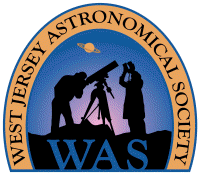| Weather Links |
Mercury 2024 |
Lunar X
|
Omega Centauri |
Barnard's Star
|
Bald Eagles |
Crescent Moon and Clouds
Atsion,
May 11, 2024

|
The West
Jersey Astronomical Society had a
Public Star Watch scheduled for the evening of
May 11, 2024, at Atsion
Field in Wharton State Forest, NJ. However, a poor weather
forecast precluded holding the event. Nevertheless, I took a
ride there in case there were any stragglers present (none
were). Here's a view of the clouds from inside the car looking
west. I did not notice the crescent Moon peeking through the
clouds at the time as I was seated in the car and it was
probably blocked by the roof line. It was only the next day at
home that I saw it near the top of the frame on my iPad.
Taken through the windshield with an iPhone 11 at 8:08 pm
EDT, five minutes after sunset, when the Moon was about 18%
illuminated (three days old) and 43.5° altitude. Automatically
exposed 1/50 second at f/1.8, ISO 80. It was mildly adjusted
(exposure and color balance) and cropped a little with the
iPad's photo gallery toiols. |
Jupiter and Uranus
April 22, 2024
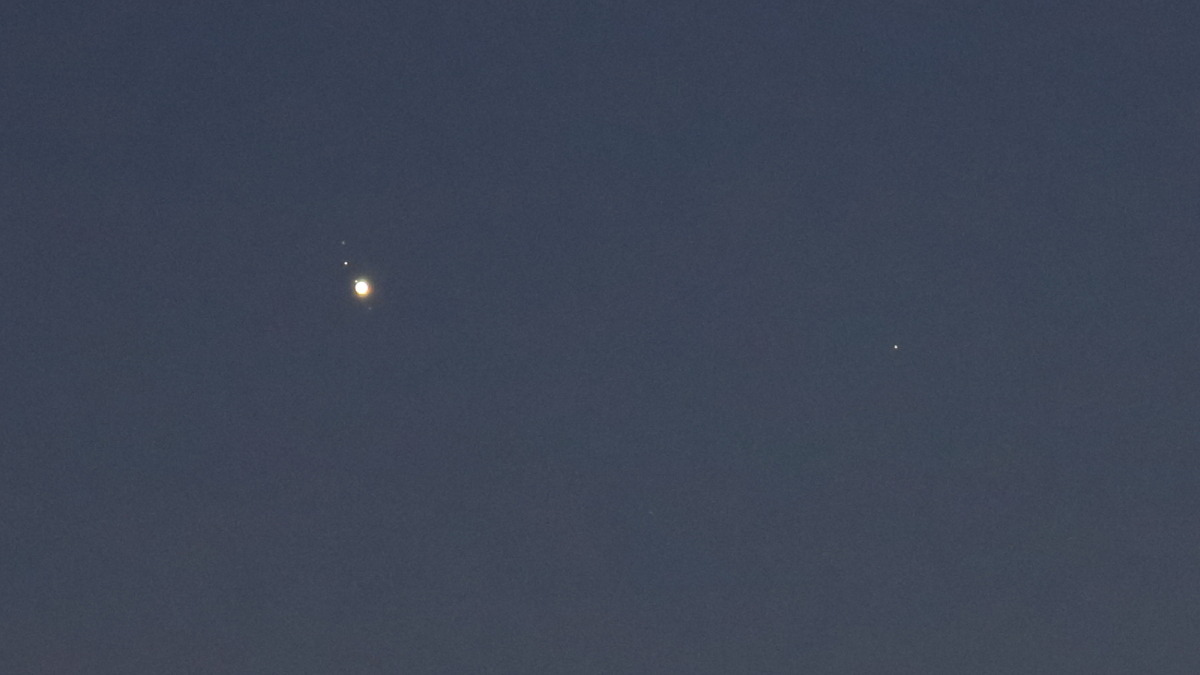
|
The distant planets
Jupiter
and
Uranus
were at formal conjunction in geocentric right ascension on
April 20, 2024, at 4 am EDT per the
USNO's MICA 2.2.2 software, with Uranus 0.53° north of
Jupiter. Their appulse (closest approach) nominally occurs when
the line between them is perpendicular to the ecliptic, when they
have the same ecliptic longitude (the
ecliptic is tilted about
23.4° to the celestial equator, so the appulse is not
necessarily at the time of conjunction). For my nominal location
of 40°N-75°W, the appulse occurred about midnight, April 20/21,
2024, when the two planets were about 30.5 arc minutes, or 0.51°
apart, per
SkyTools. Given Jupiter's orbital period of 11.8 years and
Uranus' 84 years, their conjunctions occur at approximate 13½
year intervals.
I observed the pair with my spotting scopes (88 mm, 25 to 60x,
and 115 mm, 35x) low in the west during evening twilight
on April 20, 21 and 22 when they were
0.51°, 0.53° and 0.61° apart respectively. Bright Jupiter
(magnitude -2.0) was obvious and its dim Galilean satellites
(magnitude 5.3 to 6.3) were easy to spot nearby, but similarly dim Uranus
(magnitude 5.8) was tougher to find, isolated in residual
twilight through the thickening atmosphere down low.
This snapshot of them was captured on
April 22, 2024, at 8:32 pm EDT
under a clear sky from Wharton State Forest, NJ. It's a single
raw frame taken with a Canon EOS RP DSLM camera and a Canon 400
mm f/5.6L telephoto lens on a fixed tripod. It was exposed 1/8 second at f/5.6, ISO
3200 with automatic white balance. It was mildly adjusted with Canon's Digital Photo Professional 4, and cropped to a
16:9 ratio (about 26% of the original frame's width and 22% of
the height) for a field 1.32° wide
x 0.74° high, then converted to this JPEG. At the time, Jupiter
was about 7.6° altitude, Uranus about 7.5° altitude. Notice the
change in relative position of the two planets compared to the
picture below, taken 10 days earlier. Mouseover for labels
in each case. |
Comets 12P/Pons-Brooks and 13P/Olbers
April 13, 2024
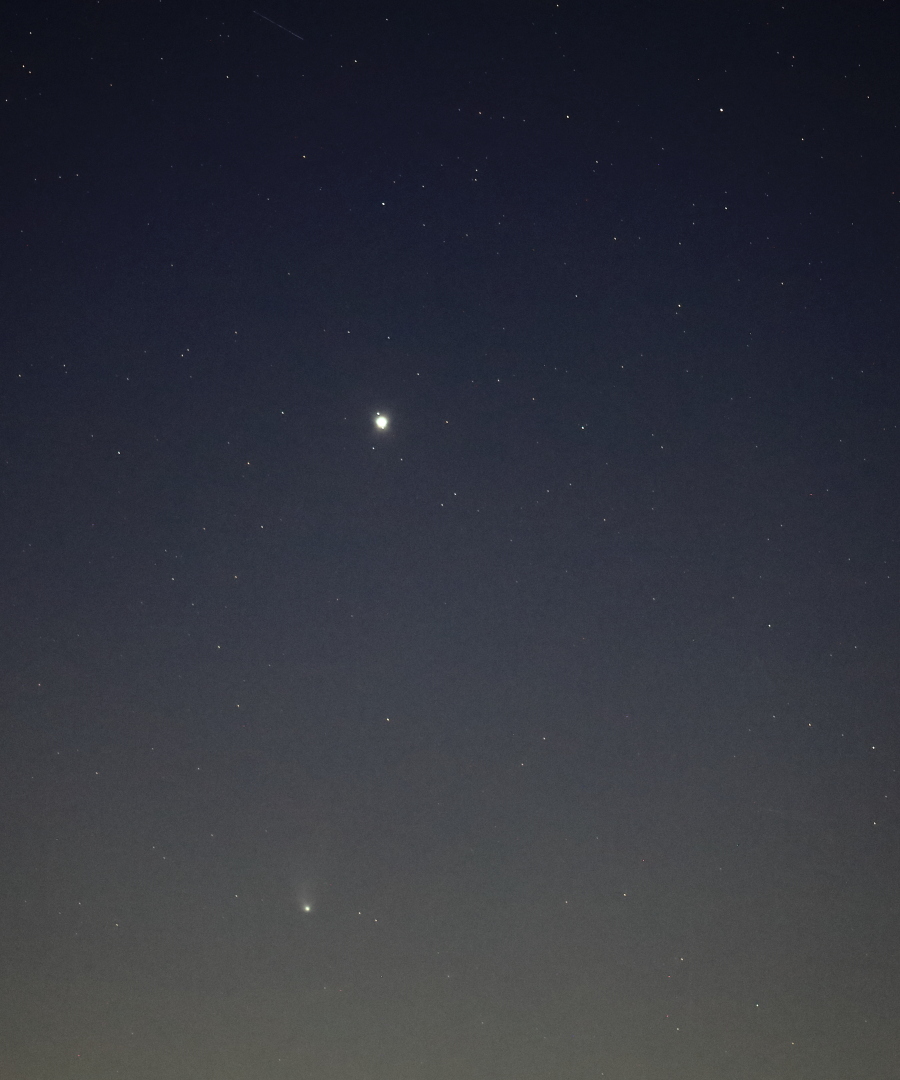
|
Comet
12P/Pons-Brooks
was 3.0° below the planet
Jupiter, which in turn was 1.3°
below the planet
Uranus
on
April 13, 2024, as viewed
from Thompson's Beach, NJ, on the north shore of the Delaware
Bay under a clear sky, but with a 32% illuminated Moon about 48°
above 12P. At the time,
12P was
in the magnitude 4+ range. Taken at 8:48 pm EDT (when 12P
was about 21.4° altitude) with a Canon EOS RP DSLM camera and a
Canon 200 mm f/2.8L telephoto lens on a fixed tripod. It was
exposed 2 seconds at f/2.8, ISO 4000, then mildly adjusted with
Canon's Digital Photo Professional 4, and cropped to a field
5.3° wide x 6.3° high. Mouseover for labels.
Visually, the comet was initially detected with my 88 mm spotting scope
at 8:24 pm,
then easily seen with my 115 mm spotting scope using the 35x
binocular eyepiece module. Subsequently, it was seen with 15x56
binoculars, but remained unseen with unaided eyes. Uranus was
also seen with the scopes and the binoculars.
Update, April 15, 2024: Comet 12P
was spotted on April 15 at 8:42 pm EDT from suburban Bishops Gate in
Mt Laurel, NJ, with the 115 mm spotting scope and the 35x
binocular eyepiece module. Update April
16: Despite some thin clouds towards the WNW and a
62% Moon in an otherwise clear sky at Wharton SF, NJ, using the
35x115 spotting scope, I located 12P at 8:41 pm, 6.4° altitude,
and 13P at 8:52 pm, 20.0° altitude. Update
April 20: 12P was spotted at 8:33 pm from Wharton SF with
the 35x115 scope. It was a dim patch of haze (and with averted
vision, a stellar core) at 6° altitude, just above mag 3.8 Xi
Tauri, under a clear sky with a 92% waxing Moon. 12P was not
seen with 15x56 binoculars. This is likely my last sighting of
12P. About 8° away at the 2 o'clock position, Jupiter and
Uranus were about half a degree apart and easily fit in the same 1.8°
field of the 35x115 scope. They would be at formal conjunction a
few hours later, around midnight. Just after 9 pm, the star field
around 13P was confirmed, and perhaps a small patch of
haze was seen at 13P's expected position. Around 9:30 pm, the
location of NGC 3621 in Hydra was found with the 35x115 scope,
but neither the galaxy nor the approximate mag 12 SN 2024ggi in
it were seen; too low and too much Moon. |
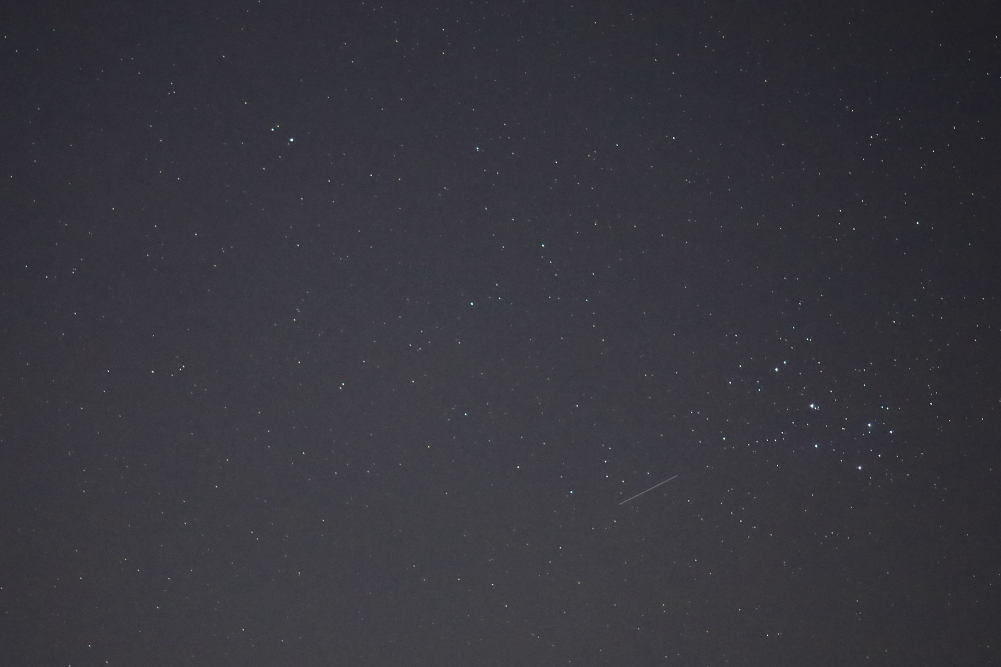
|
After spotting comet
12P/Pons-Brooks, I looked for
fainter comet
13P/Olbers, which
was about 15.5° above 12P and 5.5° left of M45, the Pleiades
star cluster. I was able to spot it as a small, faint patch of
haze with the 35x115 scope, knowing the rough position from
preparing charts early that day, then confirming the position on
the chart after that sighting. At the time, 13P was in the
magnitude 9 to 10 range. This snapshot was captured at 8:55
pm on
April 13, 2024, from
Thompson's Beach, NJ. It's a single raw frame taken with a Canon EOS RP
DSLM camera and a Canon 200 mm f/2.8L telephoto lens on a fixed
tripod. It was exposed 2 seconds at f/2.8, ISO 6400, then
lightly processed in Canon's Digital Professional Photo 4. It
was cropped to a field 7.4° wide x 5.0° high. Mouseover for
labels.
The image below is the same raw/processed image as the one
above, except that it's cropped to a field 2.0° wide x 1.3° high
to better show the faint hazy spot of comet 13P. Mouseover
for labels. |
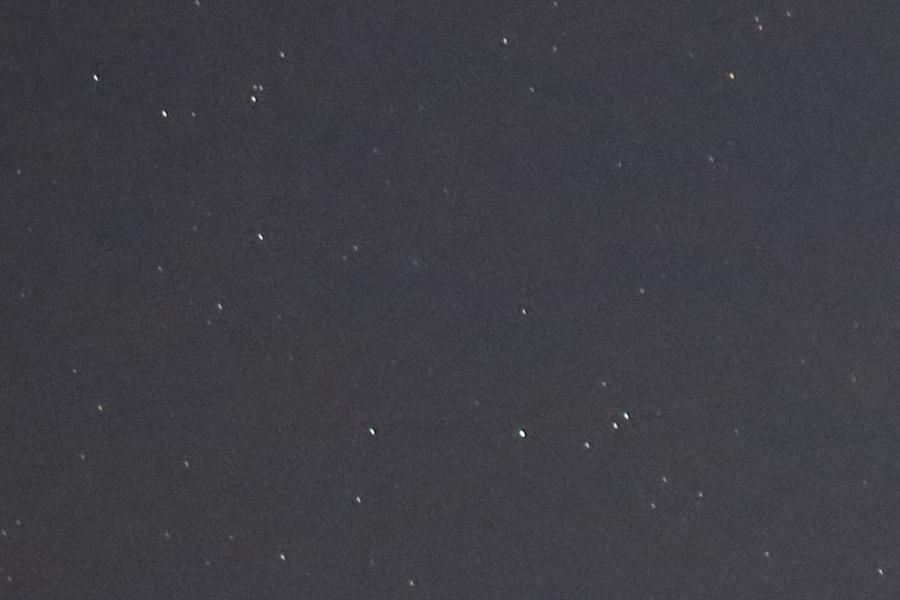
Penumbral Lunar Eclipse
March 25, 2024
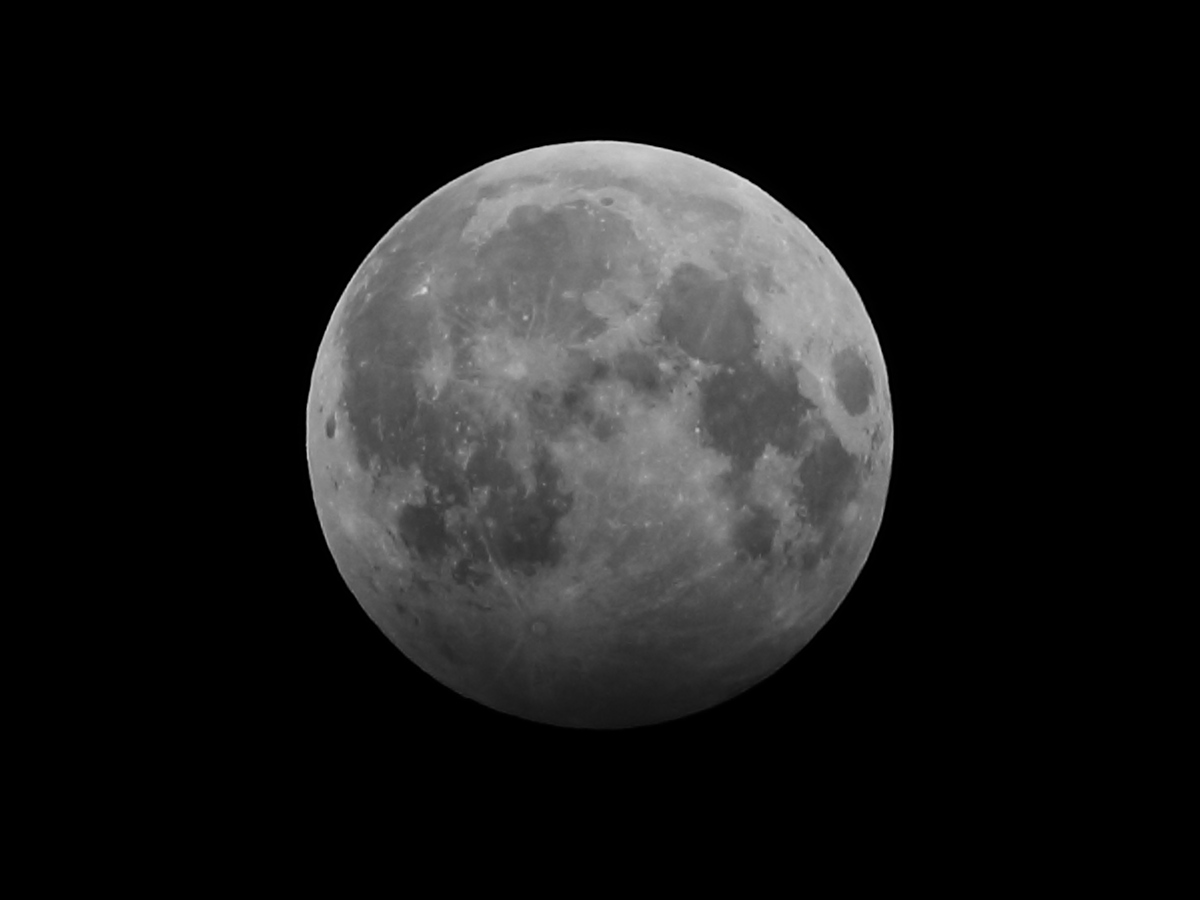
|
The
Full Moon
was at the mid-point of a deep penumbral eclipse on
March 25, 2024, when this
image was captured at 3:13 am EDT from Maple Shade, NJ. This is
a single raw frame taken under a clear sky with a Canon EOS RP
DSLM camera and a Canon 400 mm f/5.6L telephoto lens on a fixed
tripod. It was exposed 1/800 second at f/11, ISO 800 (the "Looney
Eleven" rule-of-thumb for lunar exposure) and set to
monochrome mode. Using Canon's Digital Photo Professional 4,
contrast was enhanced and it was cropped to a 4:3 ratio using
about 20% of the original frame dimensions for a field 1.0° wide
x 0.75° high, then converted to this JPEG.
Visually, the darkening towards the bottom of the lunar disc was
barely detectable with unaided eyes. Had I not known there was
an eclipse in progress, it probably would have gone unnoticed.
With 15x56 binoculars, the darkening was slightly more apparent.
Here's some
more information. |
T Coronae Borealis, the "Blaze Star"
March 13, 2024
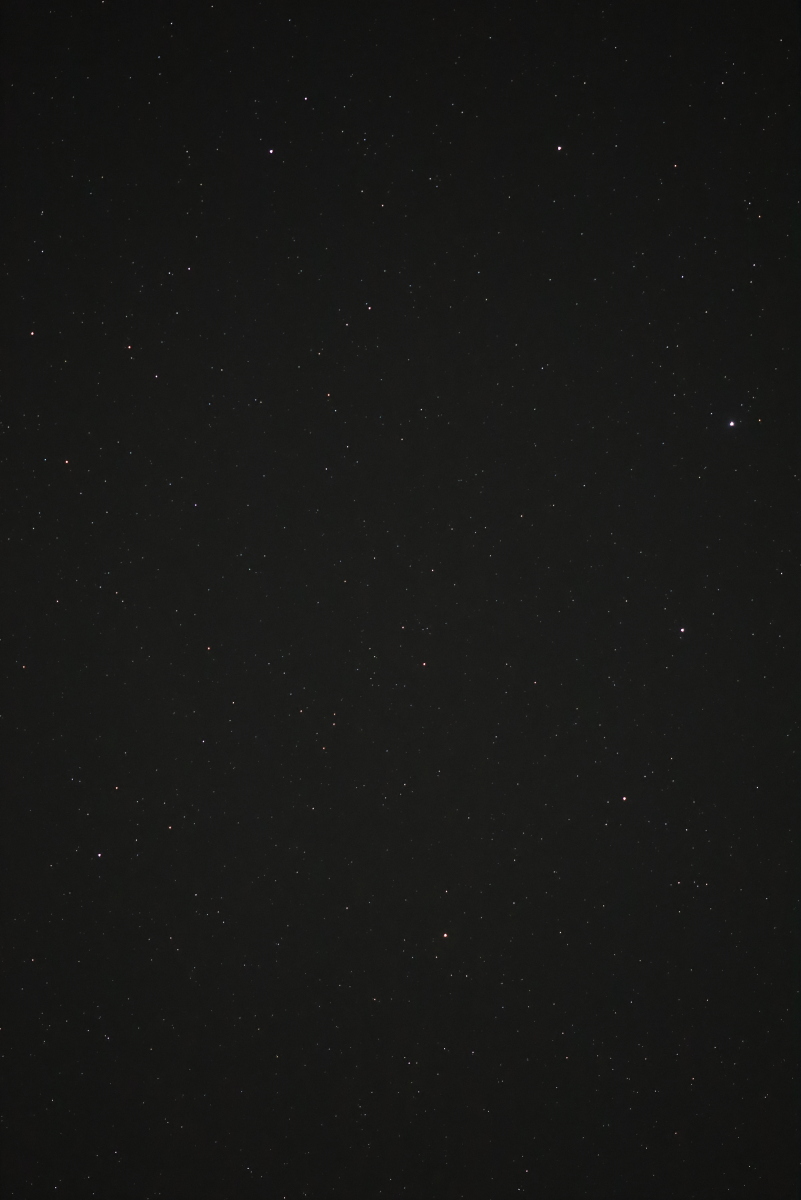
|
Here's the semi-circle of stars comprising the stick figure of
the constellation
Corona Borealis (the Northern Crown) as seen on
March 13, 2024, from
Wharton State Forest, NJ. Mouseover for labels. In
particular, it includes the recurrent nova,
T Coronae Borealis,
which is also known as the
Blaze Star
(not to be confused with the late New Orleans stripper,
Blaze Starr). T CrB is
expected to erupt in the near future from it's
current brightness, nominally magnitude 10.5 visually, to
potentially as bright as magnitude 2.0. There is an extensive
article about this object in the March 2024 issue of Sky &
Telescope magazine, beginning on page 34, and an online
Bob King article posted on June 26, 2024.
The purpose of this snapshot was to have a baseline "before" reference,
while T CrB was in its quiescent state. It was taken at 2:30 am EDT with a Canon EOS RP DSLM
camera plus a Canon 200 mm f/2.8L
telephoto lens on a fixed tripod. It's a single raw frame
exposed 2 seconds at f/2.8, ISO 10,000. It was not adjusted,
just converted to this JPEG with Canon's Digital Photo
Professional 4. The view is 6.9° wide x 10.3° high, but
at that scale, T CrB is barely visible, so
a magnifying crop was was extracted for a better view (see the
image below). The zenith is towards the top, north is
approximately at the 10 o'clock position and east is at 7
o'clock. Alphecca is magnitude 2.2, Epsilon CrB is magnitude 4.2.
T CrB was also seen visually with an 88 mm
spotting scope at 60x. It was faint, but unequivocally there.
Comparing it to nearby field stars, the brightness appeared
consistent with contemporaneous
AAVSO visual magnitude estimates
around
10.5. |

|
Here's the magnifying crop taken from the bottom of the same raw
frame as the image above. Besides cropping to a field 2.5° wide
x 1.6° high, no other adjustments were made (although a red-colored hot
pixel was retouched). Epsilon CrB and T CrB are 63 arc minutes apart (1° 03′). |
Venus and the Old Crescent Moon
March 8, 2024

|
Venus
and the crescent
Moon
would were just 6° apart as the rising Moon cleared the distant tree
line in brightening morning twilight on
March 8, 2024, as seen
from Marter Ave in Mt Laurel, NJ, at 5:42 am EST, 39 minutes
before sunrise at 6:21 am EST.
Mars
was about 5° above the Moon, but much dimmer and lost in the
cloudy patch, or perhaps just outside the frame. At the time,
Venus at 2.6° altitude, while the Moon was at 1.0° altitude (to the lunar center,
including atmospheric refraction). The Moon was
5.6% illuminated and 46 hr 14 min before new on March 10 at 5:00
am EDT. That's almost two days, but because the ecliptic is now at
such a shallow angle to the horizon before sunrise, about 28°,
and the Moon has a 5.2°S ecliptic latitude, its solar
elongation, about 27°, is more sideways than upwards. Note that
a leftward line perpendicular to mid-crescent (towards the Sun)
slants just
slightly down.
Mouseover for labels.
This is a single raw frame taken with a
Canon EOS RP DSLM camera and a Canon 70 to 200 mm f/2.8L telephoto
zoom lens (on a fixed tripod), set to 135 mm focal length. It
was exposed 1/25 second at f/5.6, ISO
1600, auto white balance, The only post processing was cropping
it vertically to a 16:9 ratio for a field 10.1° wide x 5.7° high,
then converting it to this JPEG in Canon's Digital Photo
Professional 4, then slightly enhancing Venus in Adobe Photoshop
Elements.
Venus was first noticed on arrival with
unaided eyes just above the tree tops at 5:35 am, 0.8° altitude. The upper cusp of the
lunar crescent was first noticed with unaided eyes rising out of the trees at 5:43
am. Here's
a snapshot of it taken at 5:44 am using the same camera and lens,
but cropped to a 2.9° wide x
1.7° high field.
Here's the
crescent at 6:05 am when it had risen into a blue sky, same camera but with a 400 mm telephoto lens, uncropped for a field
5.1° wide x 3.4° high. Both Venus and the Moon were still
visible to unaided eyes at 6:08 am when I packed up. Dimmer Mars, magnitude +1.2, was
not seen with unaided eyes, but it was briefly seen with
8x42 binoculars around 5:53 am through a thin patch of the
persistent cloud above the Moon (the cloudy area at the top-right of the frame above). |
Comet 12P/Pons-Brooks
March 3, 2024
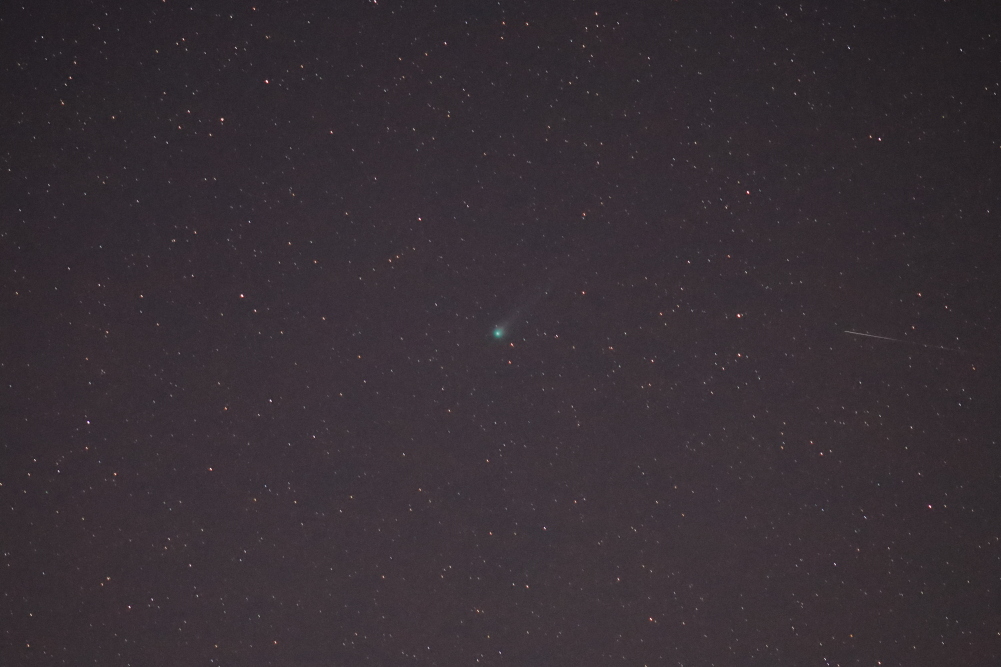
|
On
March 3, 2024, comet
12P/Pons-Brooks
was captured from the Thompson's Beach, NJ, nature observation
platform's parking lot near the north shore of the Delaware Bay.
This comet had reached a nominal
magnitude 6, such that this simple snapshot showed a
greenish color and the fainter tail it was sporting. Taken at
7:11 pm EST with a Canon EOS RP DSLM plus a Canon 200 mm f/2.8L
telephoto lens on a fixed tripod. It's a single raw frame
exposed 4 seconds at f/2.8, ISO 5000. It was mildly adjusted,
cropped to 64% of the original dimensions for a field 6.6° wide
x 4.4° high, then saved to this JPEG with
Canon's Digital Photo professional 4. EST. The light
streak near the right edge is a satellite.
At the time, 12P was at 20.6° altitude in
the constellation Andromeda, about 7° northwest of Alpheratz
(Alpha And) and 11.5° southwest of the Andromeda Galaxy, M31. In
the image above, the faint tail extends about half-a-degree at a
position angle of 16° (nominally north). Here's a
wider-field
view taken at 7:31 pm with the RP plus a Canon 100 f/2.8L
macro lens on a fixed tripod showing these these objects. It was
exposed 4 seconds at f/2.8, ISO 6400, then mildly processed in
DPP4 and cropped to 12.4° wide x 18.5° high.
Here's
a labeled version.
12P was also observed
visually, initially spotted with 12x50 binoculars at 6:49 pm, 54
minutes after sunset at 5:55 pm and 34 minutes before the end of
astronomical twilight at 7:24 pm. After taking some snapshots, I
put my 88 mm apo spotting back on the tripod and visually
observed the comet. It was easily visible at 25x, and while the
tail was much fainter than the coma, it was unequivocally seen.
Later, I was able to unequivocally see
comet
144P/Kushida (magnitude 10) as a patch of dim haze with
the 88 mm at 60x. It was in Taurus, about 4° southeast of Zeta Tauri. On February 29 from Wharton State Forest, NJ, I also saw
the tail of 12p and detected 144P with the 88 mm scope at 60x,
but in both cases, they were at he borderline of visibility. The
dark sky over the Delaware Bay makes a difference. The primary
reason I stopped at Wharton SF on the way home from Thompson's
Beach was to watch the
Falcon 9
second stage pass off the New Jersey coast, propelling the
Crew-8 Dragon capsule to the ISS. The bright orange engine glow
and the parabaloidal exhaust cloud were spectacular in 15x56
binoculars, filling the 4.5° FOV towards SECO (second stage
engine cutoff). The cloud was visible,
but less impressive,
with unaided eyes. It first appeared out of the tree tops at 11:00 pm EST,
ending
near Spica just before 11:02 pm.
The image below shows the setting Sun from the Thompson's Beach
parking lot at 5:53 pm on March 3, 2024, two minutes before sunset at
5:55 pm. The Sun was at 262°
azimuth (almost due west, 270°), 16 days before the northern
hemisphere's Vernal Equinox on March 19 at 11:06 pm EDT, when
the Sun actually rises in the east and sets in the west. Taken
with an iPhone 11, handheld. The white
streak near the top is an aircraft contrail. |

Venus and Mars
in Conjunction
February 22, 2024
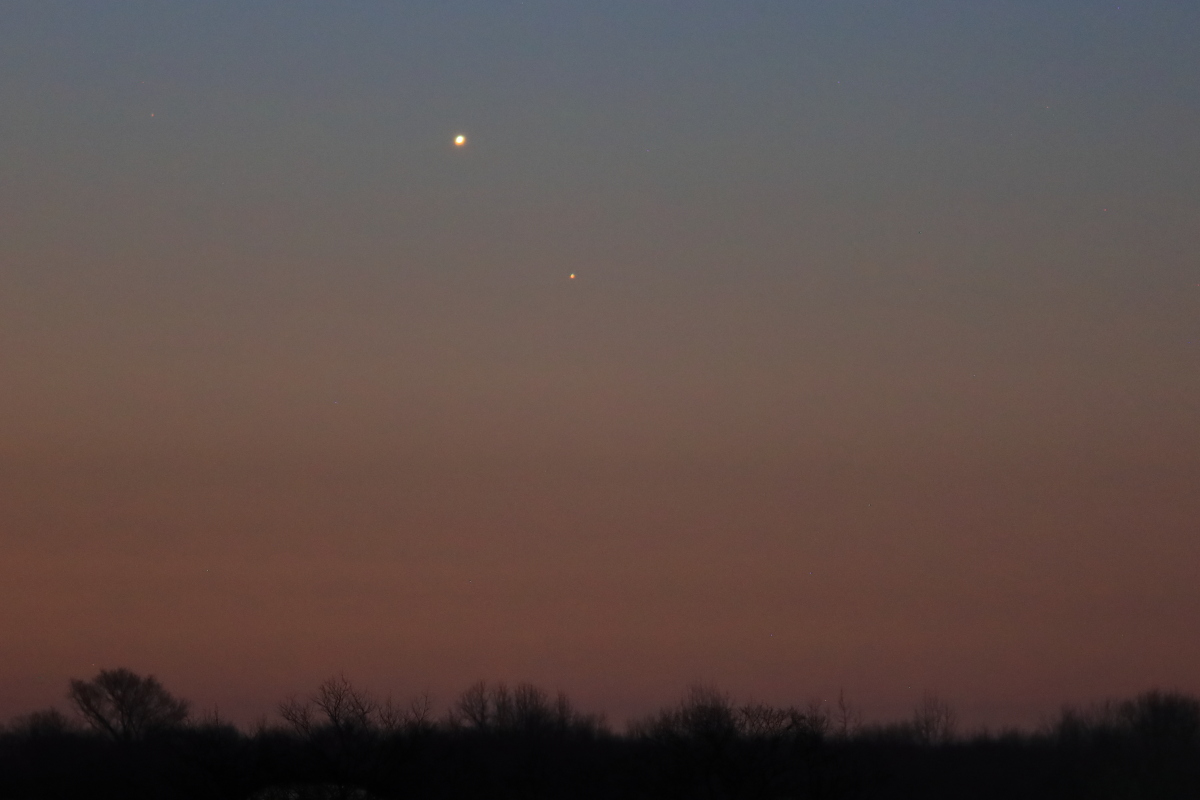
|
Venus
and
Mars
would reach conjunction in geocentric right ascension at 11 am
EST on
February 22, 2024, but
their appulse (closest approach) would occur at 4:48 am in the
constellation of Capricornus. This snapshot was captured
from Marter Ave in Mt Laurel, NJ, about an hour later at 5:51 am, when the two planets had an
apparent separation of 0.62°. Brighter
Venus
(magnitude -3.9) is at 2.7° altitude while dimmer
Mars
(magnitude +1.3) is below-right of Venus at 2.3° altitude. Venus
was at an ecliptic latitude of 0.4°S and a line from Venus
through Mars was essentially perpendicular to the ecliptic,
which was oriented from lower left to upper right.
Mouseover for labels.
This is from a single raw frame taken with
a Canon EOS RP DSLM camera and a Canon 400 mm f/5.6L telephoto
lens on a fixed tripod. It was exposed 0.6 second at f/5.6, ISO
3200, auto white balance, then slightly adjusted in Canon's
Digital Photo Professional 4 and cropped to 77% of the original
dimensions for a field 3.9° wide x 2.6° high. To the unaided
eye, Venus was obvious while
Mars could only be glimpsed with difficulty (but it was not
difficult with 12x50 binoculars).
The image below was captured on February 25, 2024, and is shown in the
same field size as the image above, showing the
relative movement between Venus and Mars. |
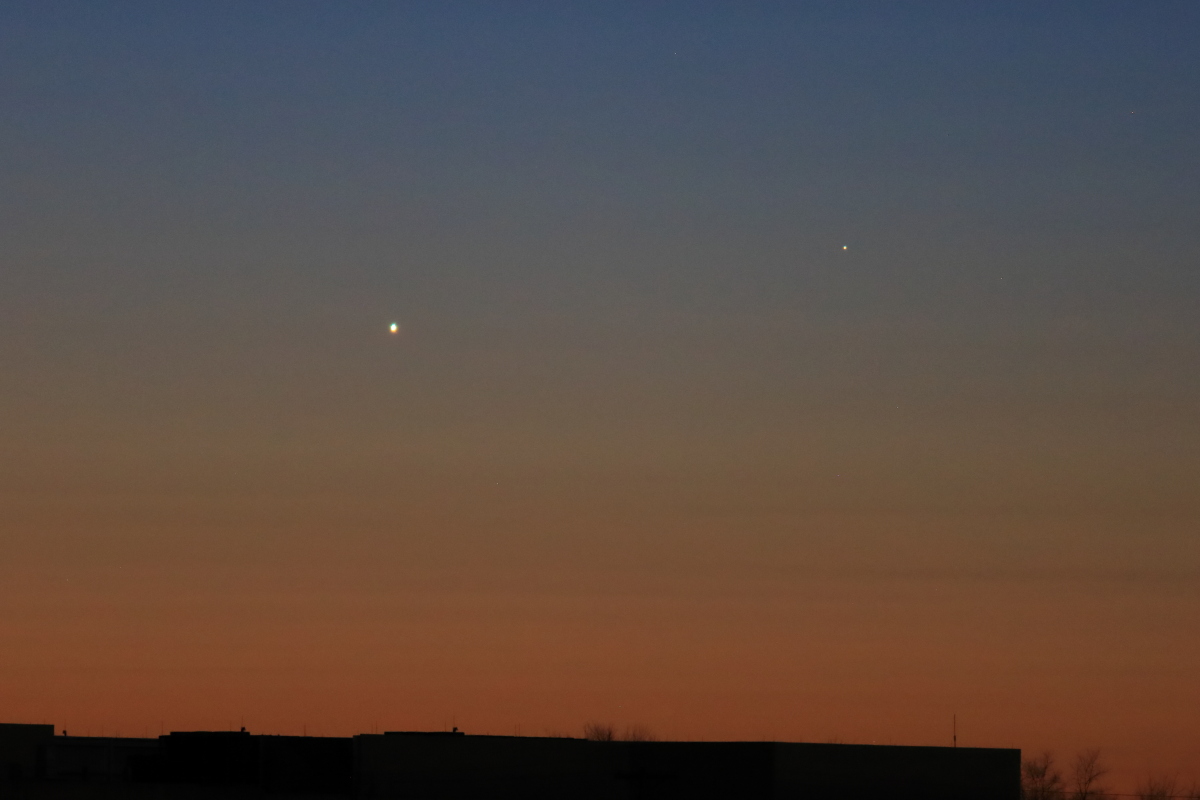
|
Venus
and
Mars
at 5:48 am
EST on
February 25, 2024, also
from Marter Ave in Mt Laurel, NJ, and three days after the
picture above. Both planets have moved eastward in that time,
but Venus more so than Mars such that Mars is about 1.6° to the
right of Venus rather than below it. At the time, Venus was
about 2.3° altitude and Mars 2.6° altitude.
Mouseover for labels.
This is from a single raw frame taken with
a Canon EOS RP DSLM camera and a Canon 400 mm f/5.6L telephoto
lens on a fixed tripod. It was exposed 1/6 second at f/5.6, ISO
3200, auto white balance, then slightly adjusted in Canon's
Digital Photo Professional 4 and cropped to 77% of the original
dimensions for a field 3.9° wide x 2.6° high (the same field
size as the previous picture). To the unaided eye, Venus was not
difficult to see while Mars was not seen against the background
twilight. |
Morning Twilight at Thompson's Beach,
New Jersey
February 8, 2024
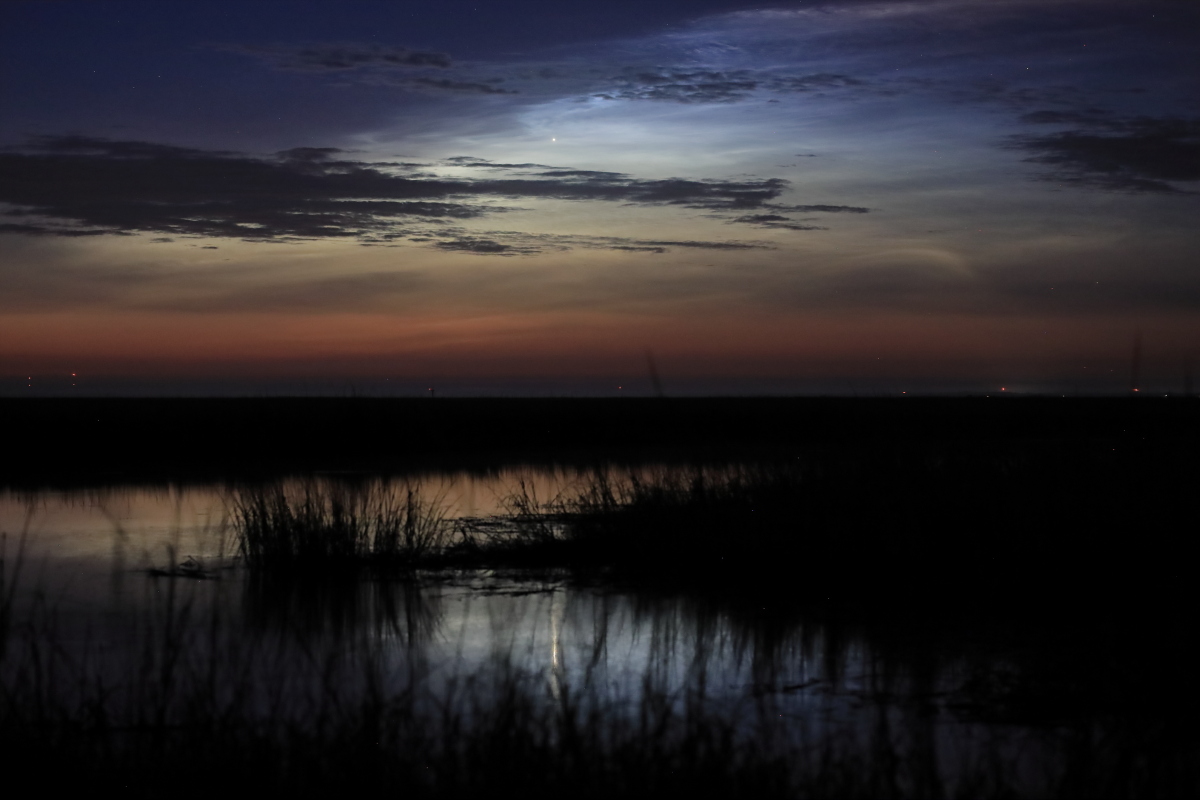
|
On the morning of
February 8, 2024, the planet Venus
was low in the southeast, at 4.7° altitude over the vast marsh
along the north shore of the Delaware Bay at Thompson's Beach, NJ,
when this snapshot was taken at 5:56 am EST. It was captured as
a single raw frame with
a Canon EOS RP DSLM camera and a Canon 100 mm f/2.8L macro lens
on a fixed tripod. It was exposed 1
second at f/4.0, ISO 3200, then mildly adjusted in Canon's
Digital Photo Professional 4. It's uncropped for a field 20.4°
wide x 13.7° high.
Mouseover for labels.
Brilliant Venus
(magnitude -4.0) was initially spotted at 5:30 am with 12x50
binoculars when it was at 0.7° altitude (note the reflection off
the water). The sky
along the eastern horizon was somewhat murky as seen in these
photos.
Mars
was spotted at 6:04 am with 12x50 binoculars when it was at 1.5° altitude, 6½° below-left of Venus, but it was faint at magnitude +1.3 against the
brightening twilight (astronomical twilight started at 5:28 am
and sunrise would be at 6:59 am). Initially, I did not think I
captured Mars in any of the many frames taken, but on February
11, I finally found one where
it
showed reasonably well. The crescent
Moon
was sighted at 6:32 am with the 12x50s (see photo farther down), but magnitude
-0.5 Mercury, about 7½° left of the Moon, was never located with
the 12x50s in the
even-brighter twilight. I didn't have the opportunity to put the
88 mm scope back on the tripod for a better search. Besides
ever-increasing twilight, I had to make a prompt exit around 6:45 am as the rising spring tide
was flooding the small parking lot.
After
I arrived about 4:15 am, 28°F, and before the start of twilight,
the first object observed was
Omega Centauri
with 12x50 binoculars at 4:21 am. I had already seen it on January 22,
but I wanted to catch it during the week of the Winter Star
Party (in Florida). Next I spotted comets
62P/Tsuchinshan
in Virgo at 4:24 am with the 88 mm scope at 25x then the 12x50s,
and
C/2021 S3 (PANSTARRS)
in Ophiuchus with the 88 mm at 60x (it was very faint). Near 62P
and also in Virgo, I was able to detect the core of the host
galaxy NGC 4216 with the 88 mm at 4:34 am (it looked like a
fuzzy star), and at 60x with
averted vision, I may have glimpsed supernova
2024gy, but it was quite
uncertain. The SN was certainly dimmer than my last observation on
January 22, also from Thompson's Beach.
Estimates at AAVSO have faded somewhat since then, from
the peak about magnitude 12.8 to the mid 13's. Slow moving
clouds finally moved enough that I was able to spot comet
12P/Pons-Brooks
in Cygnus at 5:23 am with the 88 mm, then with the 12x50s.
The previous evening, February 7, I went to Wharton State Forest
after sunset (5:25 pm, astronomical twilight ended at 6:56 pm).
I was able to spot
12P
at 6:28 pm with the 88 mm scope, then afterwards saw it with the
12x50s. With the 88 mm at 60x, I noticed a faint, vague haze
extending towards a pair of eighth magnitude field stars, which
matched the tail direction line on my SkyTools chart. At 6:40
pm, I spotted the asteroid/minor planet
(4) Vesta
between the horns of Taurus. Then at 6:53 pm, I located comet
144P/Kushida
with the 88 mm at 60x, near the close pair of stars Theta 1 & 2 Tauri
in the Hyades star cluster. 144P was rather faint, and when I first
compared it to my SkyTools chart, it appeared to be in the wrong place, so
I figured I didn't really see it. However, looking at the chart
again, I realized I was looking at the comet symbol backwards at
first, and once that was recitfied, 144P's position was spot on.
So, overnight February 7-8, 2024, I saw four (4) different
comets, and one of them, 12P/Pons-Brooks, twice — once before
setting in the evening and then again after rising the next
morning (so, 4½ comets?). At about +38° declination, 12P was
within 12° of the +50° declination threshold for being
circumpolar at our nominal 40°N latitude. |
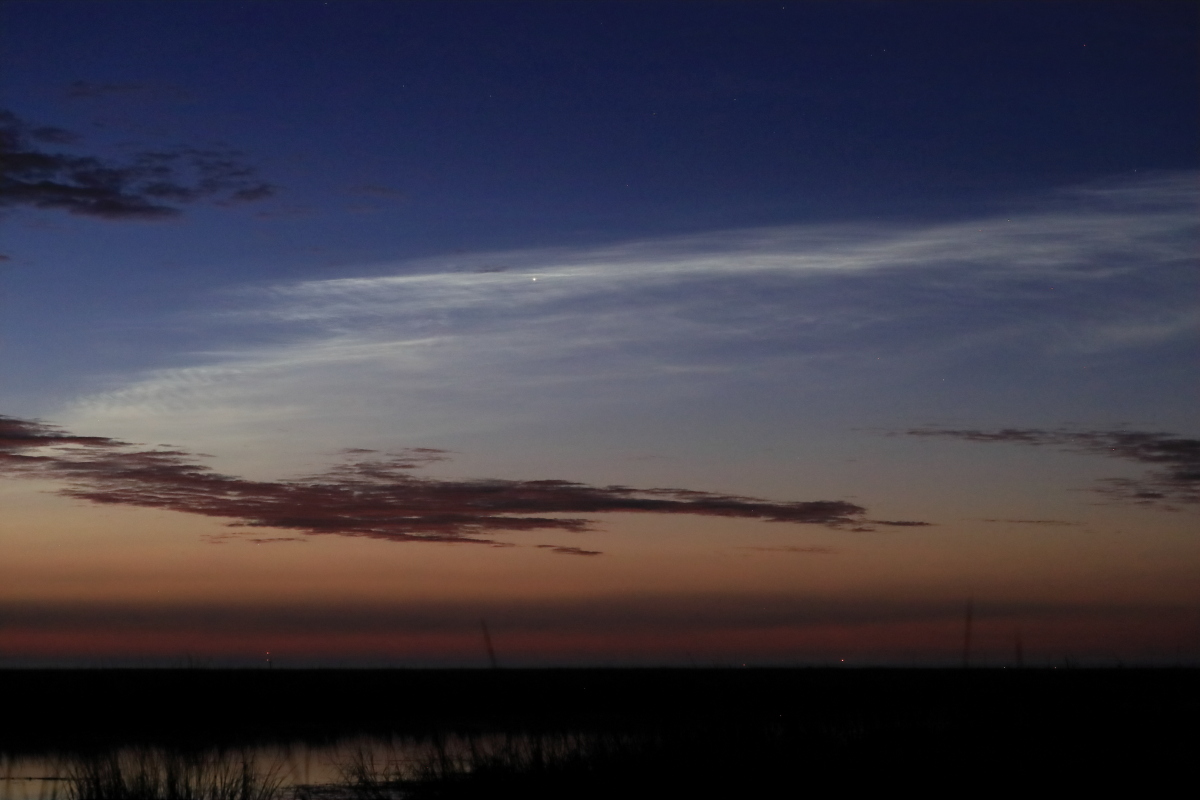
|
Venus
had risen to 6.7° altitude at 6:09 am EST on
February 8, 2024, when
this snapshot was taken with Canon EOS RP DSLM camera and a Canon 100 mm
f/2.8L macro lens on a fixed tripod. This image is from a single
raw frame exposed 1/6
second at f/5.6, ISO 3200, then mildly adjusted in Canon's
Digital Photo Professional 4. It is uncropped for a field 20.4°
wide x 13.7° high.
Mouseover for a label.
Usually in the morning before sunrise, the clouds along the
horizon are dark, like the the one well below Venus, since they would
be backlit. The white cloud must have been front lighted by
the sun, and to be so, it must have been quite high in the
atmosphere and/or very distant. It's reminiscent of a
noctilucent cloud, but unlikely to be one since such clouds are rare at our
latitude, let alone at this time of the year and looking
southeast Here's a
Bob King S&T article about summer's noctilucent clouds.
Update, July 7, 2024:
After seeing a number of pictures at the Spaceweather photo
gallery showing "artificial"
noctilucent clouds from rocket launches, I searched the web and
found there was a Falcon 9 launch out of Cape Canaveral at 1:33
am EST on February 8, 2024, carrying the
PACE satellite into a polar orbit (98° inclination).
Residual rocket exhaust from this launch may be the
source of these bright clouds. |
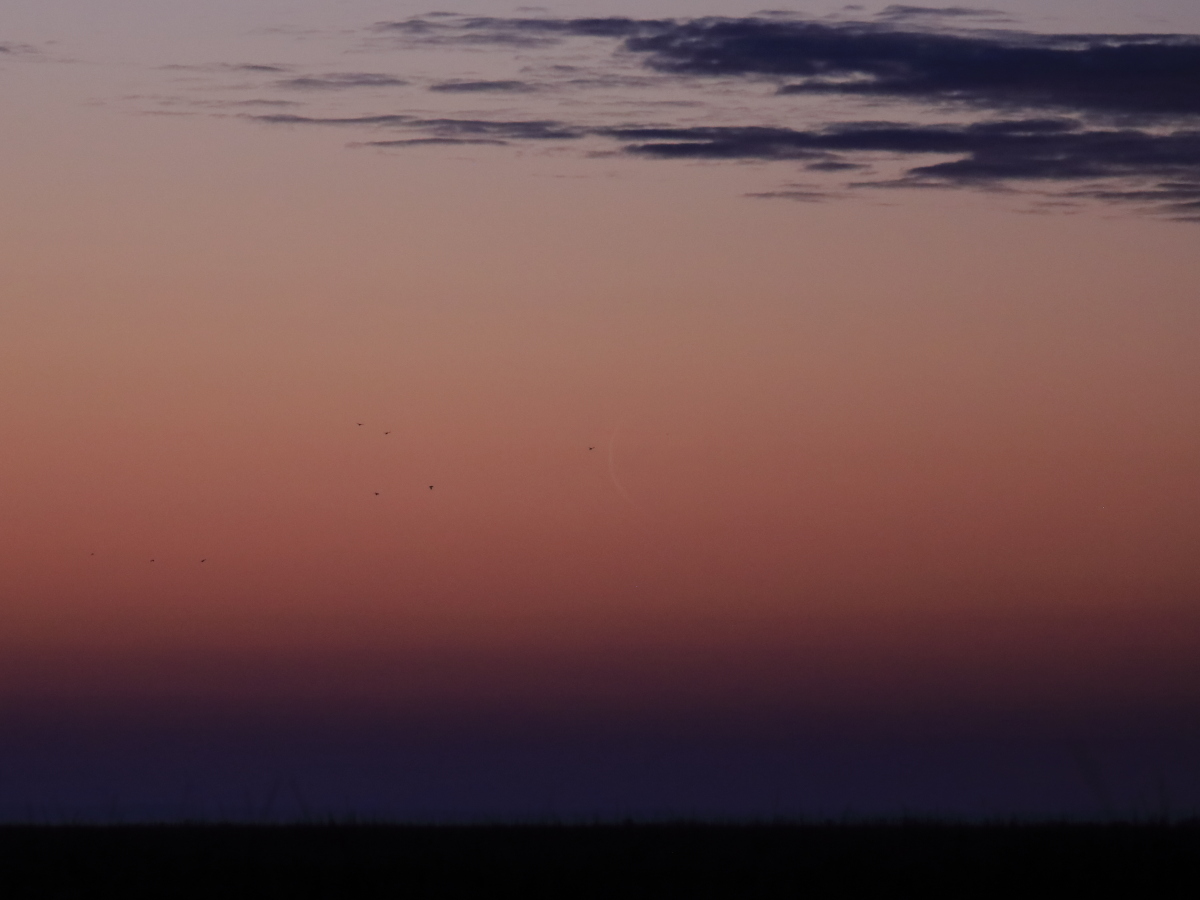
|
The thin crescent
Moon, 3.3%
illuminated, and some
distant birds in flight, were captured at 6:38 am EST on
February 8, 2024. This
snappshot is from a single raw frame taken with Canon EOS RP DSLM
camera and a Canon 400 mm f/5.6L telephoto lens on a fixed
tripod. It was exposed 1/500
second at f/5.6, ISO 3200, then mildly adjusted in Canon's
Digital Photo Professional 4. It was cropped to 77% of the width
x 87% of the height for a field 4.0°
wide x 3.0° high.
Mouseover for labels.
Here's
a deeper crop, 32% of the original size for a field 1.65°
wide x 1.10° high, to better show the diaphanous crescent, plus
some birds (that crop would be the equivalent of a 1,250 mm
focal length on the "full-frame" sensor of the RP).
The Moon rose at 6:26 am, and when the picture was taken 12
minutes later (after finding it with 12x50 binoculars), it was
at 1.4° altitude, 127° azimuth and 35 hr 21 min before it would
reach
new phase at 5:59 pm on February 9. The Moon's solar elongation was
14°, but because of the shallow angle of the ecliptic with
respect to the
horizon, about 33°, and the 5.8°S ecliptic latitude, much of the
Moon's displacement from the Sun was horizontal rather than
vertical, hence the low altitude in strong twilight. This
resulted in a faint, low contrast crescent against the
brightening background twilight, both in the picture and in the binocular view. |
Supernova 2024gy on a Snowy Morning
January 20, 2024
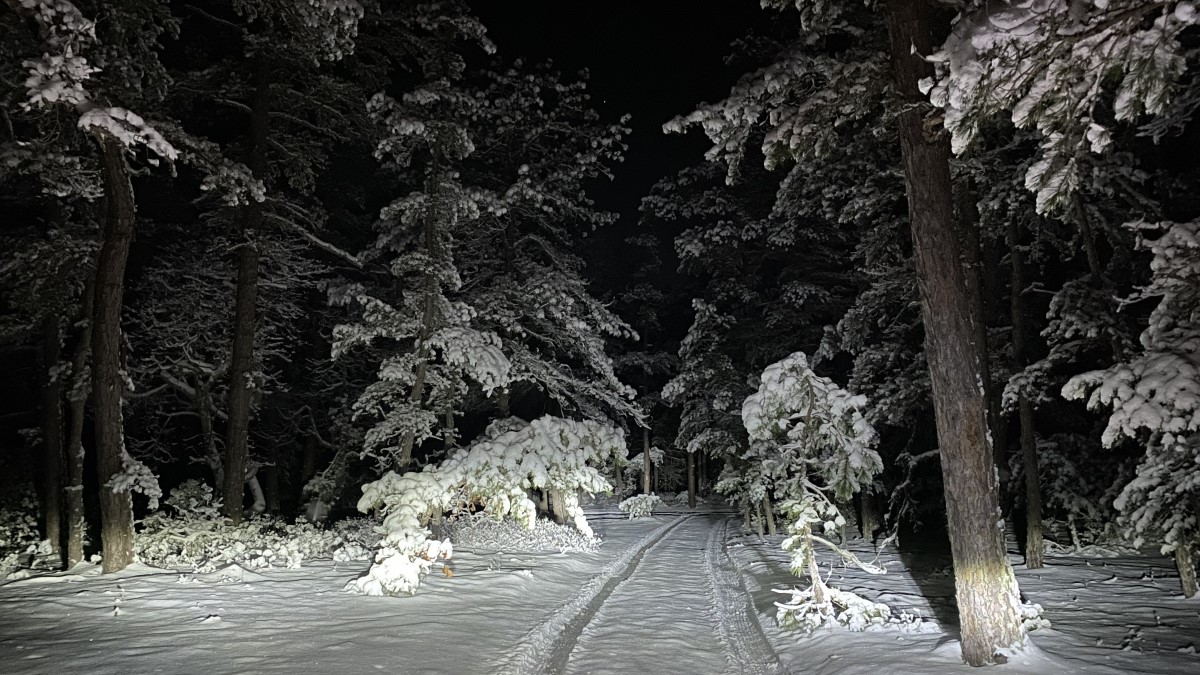
|
We had a snowfall of about 4 inches during the day on January
19, 2024. After it stropped snowing and the sky cleared that
evening, I wanted to follow-up on
Supernova 2024gy in the galaxy NGC 4216 (Virgo) that I had
tenuously observed on the morning of January 17 with my 88 mm
(3.5 inch) spotting scope. The waxing gibbous Moon would set
about 3 am on January 20, so I headed to Wharton State Forest
with my 115 mm (4.5 inch) spotting scope for another look. At
3:30 am EST, I located NGC 4216 and I could make out a very
faint elliptical shape (vs. just the core with the 88 mm scope)
and unambiguously saw the SN with averted vision south of the
core. I was even able to glimpse the SN with direct vision.
Visual estimates at AAVSO were around magnitude 12.8. Bob
King discussed this relatively bright supernova in his
Sky & Telescope online article.
This picture was taken afterwards, at 3:52 am on
January 20, 2024, with a handheld iPhone 11
through the windshield of my Toyota RAV4 heading down the
Batona Trail towards the field in the forest. The 4WD
negotiated the snowy ground as if there wasn't any snow, even
without the snow setting. The view of the snow-festooned trees
bracketing the back roads was spectacular, and occasional gusts
of wind generated brief blizzards. While observing, the
temperature was 19°F.
Update: On January
22, 2024, I went to Thompson's Beach on the north shore of the
Delaware Bay in Cumberland County, NJ. Looking at the dark sky
over the bay, Using averted vision, I was confident that I saw
SN 2024gy, and a wisp of the elliptical shape of galaxy
NGC 4216, with my 88 mm spotting scope at 60x. I was also able
to see comet 62P/Tsuchinshan with
15x56 binoculars and the 88 mm scope. With a clear sky all the
way down to the sea-like marsh horizon, I was also able to
easily see the
great globular cluster, Omega Centauri,
which only reaches 3.5° altitude from there. Finally, the
planets Venus,
Mercury and
Mars were each picked up at less than half a degree
altitude in the southeast; Venus with unaided eyes, Mercury and Mars with the 88
mm scope at 25x. Several other deep-sky objects were casually
spotted with the 15x56s, e.g., M4, M80, M10, M12, M104, M66 and
possibly M65. |
Mercury,
Venus and the Crescent Moon
January 8, 2024

|
The waning crescent Moon
joined Venus
and Mercury
on the morning of
January 8, 2024, when this snapshot of them
was captured from Bishops Gate in Mt Laurel, NJ.
This is a single frame taken at 6:33 am EST, with a
handheld
iPhone 11 resting on my spotting scope mount, 48
minutes before sunrise at 7:21 am. For reference, Venus is about 17°
altitude at 137° azimuth (southeast). It was automatically exposed 1/5
second at f/1.8, ISO 500. Except for cropping and some mild
brightness enhancement of Mercury and the dimmer stars, it's
unprocessed.
Mouseover for labels.
Mars
was spotted at 6:36 am with an 88 mm spotting scope near the
treetops, three minutes after the picture was taken (my first
sighting of it for this apparition; it was last seen on the
evening of October 15, 2023).
Earlier, at nearby Marter Ave, a lunar occultation of Alniyat
(Sigma Sco) was observed with the 88
mm scope. Ingress was seen at 5:01 am and an abrupt egress at
5:36 am (at 2.6° and 7.5° altitude respectively). Later that day
at the Barnegat Rd Observing Site in the NJ Pines, I saw the
planets
Saturn,
Neptune,
Jupiter
and
Uranus
(from west to east) with 15x56 binoculars, all but Neptune with
unaided eyes and all but Saturn with a 12.5 inch Dob. So, all
seven planets (eight including the earth) were seen on a single
calendar day, January 8, 2024. In addition, the asteroid/minor
planet
(4) Vesta
and comet
144P/Kushida
were seen. |
Click here
for the previous page.
Click here
for an index to all previous SJAstro pages.


















